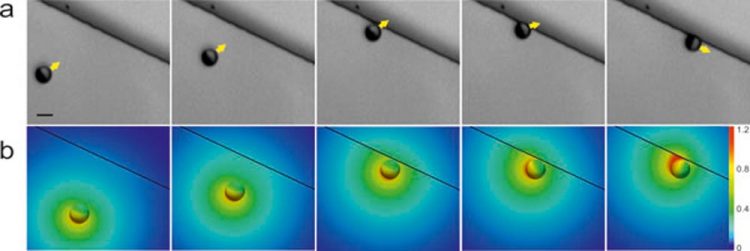Micromotors use surface variations for docking and guiding

An active particle approaches a micro-fabricated step and orients along it due to chemical activity and hydrodynamic interactions. MPI for Intelligent Systems, Stuttgart
Samuel Sánchez and Mykola Tasinkevych's ‘microswimmers’ are usually guided through fluids using specially engineered magnetic multilayer coatings, which combined with external magnetic fields, helps to control their trajectory.
This new study, the result of a collaboration between experimental research and theory, demonstrates that the particles can use the features of the surfaces over which they swim to change their direction of motion.
“Micromotors tend to settle and move near surfaces, and we’ve seen that this tends to interfere with their swimming behaviour,” says group leader and ICREA research professor Samuel, who heads the Smart Nano-Bio-Devices group at IBEC and Stuttgart’s MPI-IS. “This led us to explore new methods to guide micromotors using surface alterations.”
Using a microfabrication process, the researchers modified surfaces to create a series of indentations or steps, several times smaller than the radius of the particle, which a specific type of micromotors – Janus particles, whose surfaces have two or more distinct physical properties – can use as signals to follow a particular path. This strategy is inspired by the one used by molecular motors in natural systems, where inside the cell, motor proteins bind to the cytoskeleton filaments to achieve directional motion.
The Janus particles are prepared by coating half of a silica particle with platinum. While the platinum face acts as a catalyst in hydrogen peroxide, the silica side remains inert, an asymmetry in chemical properties that leads to a self-propelled motion of these colloids.
The researchers noticed that the particles tend to have a stable orientation parallel to the surface, and exploited this phenomenon to guide the particles along sub-micron sized steps. They were able to demonstrate that the chemical activity of the particles and the associated hydrodynamic interactions with the nearby surfaces are responsible for the observed phenomenon.
“This finding opens up the possibility of guiding these particles along complex pathways using small changes in the surface,” explains Samuel. “This can have significant implications for the design of new artificial micromotors for a variety of applications.”
Publication:
Simmchen, J., Katuri, J., Uspal, W.E., Popescu, M.N., Tasinkevych, M., and Sanchez, S. (2016). Sculpted topographical pathways guide chemical microswimmers. Nature Communications Volume: 7, Article number: 10598, DOI:10.1038/ncomms10598
http://www.nature.com/ncomms/2016/160209/ncomms10598/full/ncomms10598.html
http://www.is.mpg.de/de/sanchez
Media Contact
All latest news from the category: Life Sciences and Chemistry
Articles and reports from the Life Sciences and chemistry area deal with applied and basic research into modern biology, chemistry and human medicine.
Valuable information can be found on a range of life sciences fields including bacteriology, biochemistry, bionics, bioinformatics, biophysics, biotechnology, genetics, geobotany, human biology, marine biology, microbiology, molecular biology, cellular biology, zoology, bioinorganic chemistry, microchemistry and environmental chemistry.
Newest articles

First-of-its-kind study uses remote sensing to monitor plastic debris in rivers and lakes
Remote sensing creates a cost-effective solution to monitoring plastic pollution. A first-of-its-kind study from researchers at the University of Minnesota Twin Cities shows how remote sensing can help monitor and…

Laser-based artificial neuron mimics nerve cell functions at lightning speed
With a processing speed a billion times faster than nature, chip-based laser neuron could help advance AI tasks such as pattern recognition and sequence prediction. Researchers have developed a laser-based…

Optimising the processing of plastic waste
Just one look in the yellow bin reveals a colourful jumble of different types of plastic. However, the purer and more uniform plastic waste is, the easier it is to…



